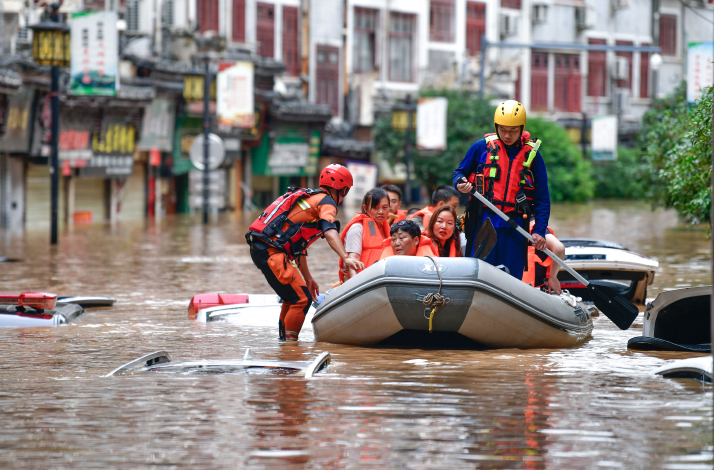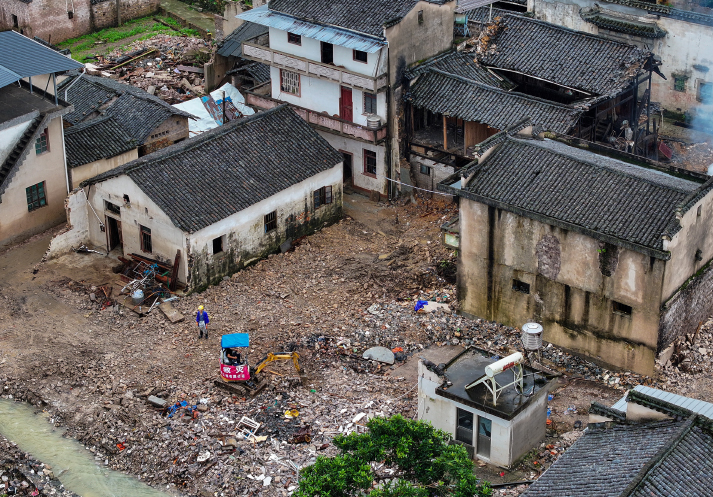| China |
| China revs up its flood control and rescue efforts | |
|
|
 Rescuers transfer flood-trapped residents in Zhenyuan County, Guizhou Province in southwest China, on June 29 (XINHUA)
Since the start of the rainy season, persistent heavy rainfall has lashed many areas in China, bringing severe floods. Actions have been taken to control floods, rescue those affected and reduce disaster damage. After red alerts were issued for rainstorms in Zhejiang, Anhui and Jiangxi provinces, China's State Flood Control and Drought Relief Headquarters (SFCDRH) on June 24 raised the flood emergency response to Level III across the regions. According to the Ministry of Water Resources (MWR), the waters of over 500 rivers in 21 provinces have exceeded warning levels this flood season due to persistent heavy downpours. In China's color-coded weather warning system, red represents the severest warning, followed by orange, yellow and blue. China has a four-tier flood-control emergency response system, with Level I being the most urgent response. The MWR has pledged to continue to monitor the rainfall and flooding, issue alerts in time, strengthen patrols of dams and better leverage reservoirs. "Rivers like those in the Yangtze River basin and the Pearl River basin, and the Songhua River in Heilongjiang Province will see floods going beyond the safety level in July," Hu Zhidan, an official with the MWR, told China Central Television. Widespread flooding According to Hu, this year's flooding in China began in April, two months earlier than in previous years. Floods had occurred in 471 small and medium-sized rivers, a number twice that in the same period of usual years, he said. On June 27, the MWR announced that the seventh heavy flood had occurred in the Pearl River basin this year. China has numbered floods reaching a certain standard of severity in a major river or lake each year. The practice is aimed at issuing alerts to warn people of flooding risks. Flood preparedness is also being tested in the Yangtze River basin in east China. Since mid-June, persistent heavy rains have caused the rise of water levels and flooding in the middle and lower reaches of the river. In east China, rainstorms in Anhui had affected 811,000 residents and forced 195,000 people to evacuate, local authorities said on June 30. By July 2, over 1.3 million people in Jiangxi had been affected by the floods, and total economic loss had reached 1.32 billion yuan ($181.5 million). According to the MWR, the Yangtze River basin saw its first flood in this year on June 28. Water levels in the tributaries of the Poyang Lake basin exceeded warning levels in late June for the first time this year. In Heilongjiang, northeast China, the water levels of 17 rivers had also exceeded warning levels by June 28. The MWR said that by June 29, the water level at the Hutou Hydrometric Station in the upper reaches of the Wusuli River in Heilongjiang had climbed to 57.99 meters, 0.9 meters higher than the maximum level considered safe and the highest since the data was first recorded in 1951. On July 2, the SFCDRH upgraded the emergency response to disasters triggered by recent severe rainfall and flooding in Hunan Province, central China, to Level III. By July 2, the Pingjiang Hydrologic Station on the Miluo River in Pingjiang County of Hunan recorded water levels of 77.63 meters, which is 7.17 meters higher than the first warning level, and the highest water level recorded since 1954. From 2 p.m. on June 30 to 2 p.m. on July 1, rainfall in Pingjiang reached 305.7 millimeters, the highest daily rainfall across China so far this year. Local Hunan newspaper the Yueyang Evening News reported that many areas across Pingjiang County had been flooded with waters as deep as three meters. "Nearly two thirds of the county's downtown areas were flooded, and many roadside stores were affected. Water and electricity supplies in the county were stopped by the flooding on July 1 and resumed on the evening of July 2. Luckily, rescuers soon came to save people who were trapped," a netizen surnamed Li, who is based in Pingjiang, wrote on the Chinese lifestyle and e-commerce app Xiaohongshu. Water levels in the county began to fall on the evening of July 2.  People clear away debris after the floods in Yixian County, Huangshan City, Anhui Province in east China, on June 28 (XINHUA)
Timely measures As the rainy season continues, China's emergency response systems remain in motion. The SFCDRH has dispatched work teams to Anhui, Jiangxi and Hunan, which remain there to help with flood prevention and control. To help combat the floods in Hunan, the China National Commission for Disaster Reduction has dispatched a team to guide and assist local governments on disaster relief and rescue. The commission and the Ministry of Emergency Management (MEM) have collected more than 100,000 donated items, including instant food, drinking water and family emergency kits for Pingjiang. The first batch of supplies reached the county's affected areas on the night of July 2. The government of Pingjiang County has sent more than 160 professional rescue teams to help rescue and transfer over 15,000 people. Authorities in Miluo City, located in the lower reaches of the Miluo River, have also worked to ensure the integrity of dams and dikes. Cutting-edge technologies have been adopted to reduce the impacts of floods. The MEM has provided two unmanned aerial vehicles to support communication in emergencies, and 38 sets of flood drainage equipment for Miluo City and Pingjiang County. As of July 2, the State Grid Hunan Electric Power Co. Ltd. had sent drones to patrol around local electricity poles, detecting over 100 potential sources of risk. The Chinese Government has allocated 150 million yuan ($21 million) to flood-stricken regions, including Anhui and Hunan, the National Development and Reform Commission said on June 28, noting that the funds will be used to repair damaged schools and hospitals, and flood control infrastructure. Chinese authorities have further allocated 45 million yuan ($6.31 million) to restore damaged roads in Anhui, Hubei and Heilongjiang. Disease prevention is also on track as the floods continue. The National Health Commission said at a press conference on June 28 that no outbreaks of infectious diseases or public health emergencies have been reported in China's flood-stricken regions. Many regions have started restoration of infrastructure as the floods receded, and business and normal life are resuming. Local authorities have also laid special focus on cultural sites with a long history. In Anhui, traditional houses are made of brick, wood and stone. Some of these ancient buildings have been damaged by flood waters including a wooden pavilion with over 1,800 years of history. In 2020, floods caused damage to 160 and 144 cultural relics in Jiangxi and Anhui, respectively. Many local authorities have introduced measures to protect ancient cultural relic sites from floods. Yixian County of Huangshan City in Anhui has over 1,500 ancient buildings built during the Ming (1368-1644) and Qing (1644-1911) dynasties. In recent days, local cultural relic protectors have been working around the clock in shifts to identify and repair leaks, and drain floodwater from the ancient houses. Zhou Shuanglin, an associate professor at the School of Archaeology and Museology at Peking University, told ThePaper.cn, "Weather forecasts should include predictions of the impacts of disasters, especially possible impacts on outdoor cultural relic sites. Precautions must be taken to mitigate the impacts of floods." BR (Print Edition Title: Preparation for Precipitation) Copyedited by G.P. Wilson Comments to lixiaoyang@cicgamericas.com |
|
||||||||||||||||||||||||||||
|